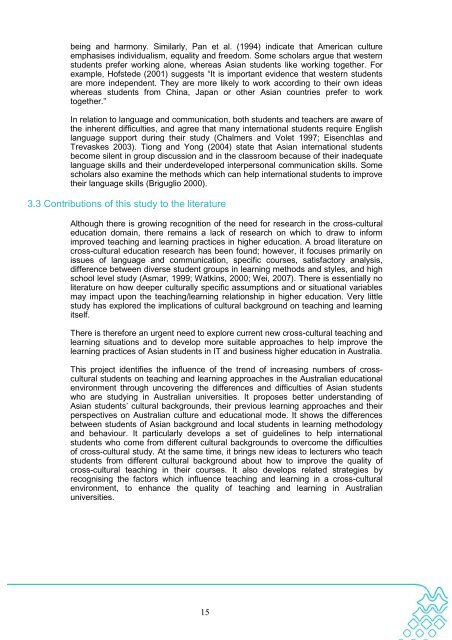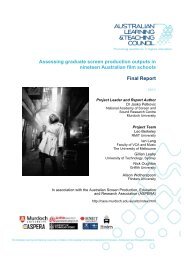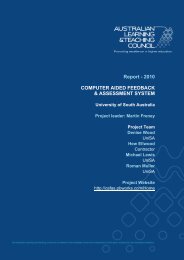Download Document - Office for Learning and Teaching
Download Document - Office for Learning and Teaching
Download Document - Office for Learning and Teaching
You also want an ePaper? Increase the reach of your titles
YUMPU automatically turns print PDFs into web optimized ePapers that Google loves.
eing <strong>and</strong> harmony. Similarly, Pan et al. (1994) indicate that American cultureemphasises individualism, equality <strong>and</strong> freedom. Some scholars argue that westernstudents prefer working alone, whereas Asian students like working together. Forexample, Hofstede (2001) suggests “It is important evidence that western studentsare more independent. They are more likely to work according to their own ideaswhereas students from China, Japan or other Asian countries prefer to worktogether.”In relation to language <strong>and</strong> communication, both students <strong>and</strong> teachers are aware ofthe inherent difficulties, <strong>and</strong> agree that many international students require Englishlanguage support during their study (Chalmers <strong>and</strong> Volet 1997; Eisenchlas <strong>and</strong>Trevaskes 2003). Tiong <strong>and</strong> Yong (2004) state that Asian international studentsbecome silent in group discussion <strong>and</strong> in the classroom because of their inadequatelanguage skills <strong>and</strong> their underdeveloped interpersonal communication skills. Somescholars also examine the methods which can help international students to improvetheir language skills (Briguglio 2000).3.3 Contributions of this study to the literatureAlthough there is growing recognition of the need <strong>for</strong> research in the cross-culturaleducation domain, there remains a lack of research on which to draw to in<strong>for</strong>mimproved teaching <strong>and</strong> learning practices in higher education. A broad literature oncross-cultural education research has been found; however, it focuses primarily onissues of language <strong>and</strong> communication, specific courses, satisfactory analysis,difference between diverse student groups in learning methods <strong>and</strong> styles, <strong>and</strong> highschool level study (Asmar, 1999; Watkins, 2000; Wei, 2007). There is essentially noliterature on how deeper culturally specific assumptions <strong>and</strong> or situational variablesmay impact upon the teaching/learning relationship in higher education. Very littlestudy has explored the implications of cultural background on teaching <strong>and</strong> learningitself.There is there<strong>for</strong>e an urgent need to explore current new cross-cultural teaching <strong>and</strong>learning situations <strong>and</strong> to develop more suitable approaches to help improve thelearning practices of Asian students in IT <strong>and</strong> business higher education in Australia.This project identifies the influence of the trend of increasing numbers of crossculturalstudents on teaching <strong>and</strong> learning approaches in the Australian educationalenvironment through uncovering the differences <strong>and</strong> difficulties of Asian studentswho are studying in Australian universities. It proposes better underst<strong>and</strong>ing ofAsian students’ cultural backgrounds, their previous learning approaches <strong>and</strong> theirperspectives on Australian culture <strong>and</strong> educational mode. It shows the differencesbetween students of Asian background <strong>and</strong> local students in learning methodology<strong>and</strong> behaviour. It particularly develops a set of guidelines to help internationalstudents who come from different cultural backgrounds to overcome the difficultiesof cross-cultural study. At the same time, it brings new ideas to lecturers who teachstudents from different cultural background about how to improve the quality ofcross-cultural teaching in their courses. It also develops related strategies byrecognising the factors which influence teaching <strong>and</strong> learning in a cross-culturalenvironment, to enhance the quality of teaching <strong>and</strong> learning in Australianuniversities.15
















